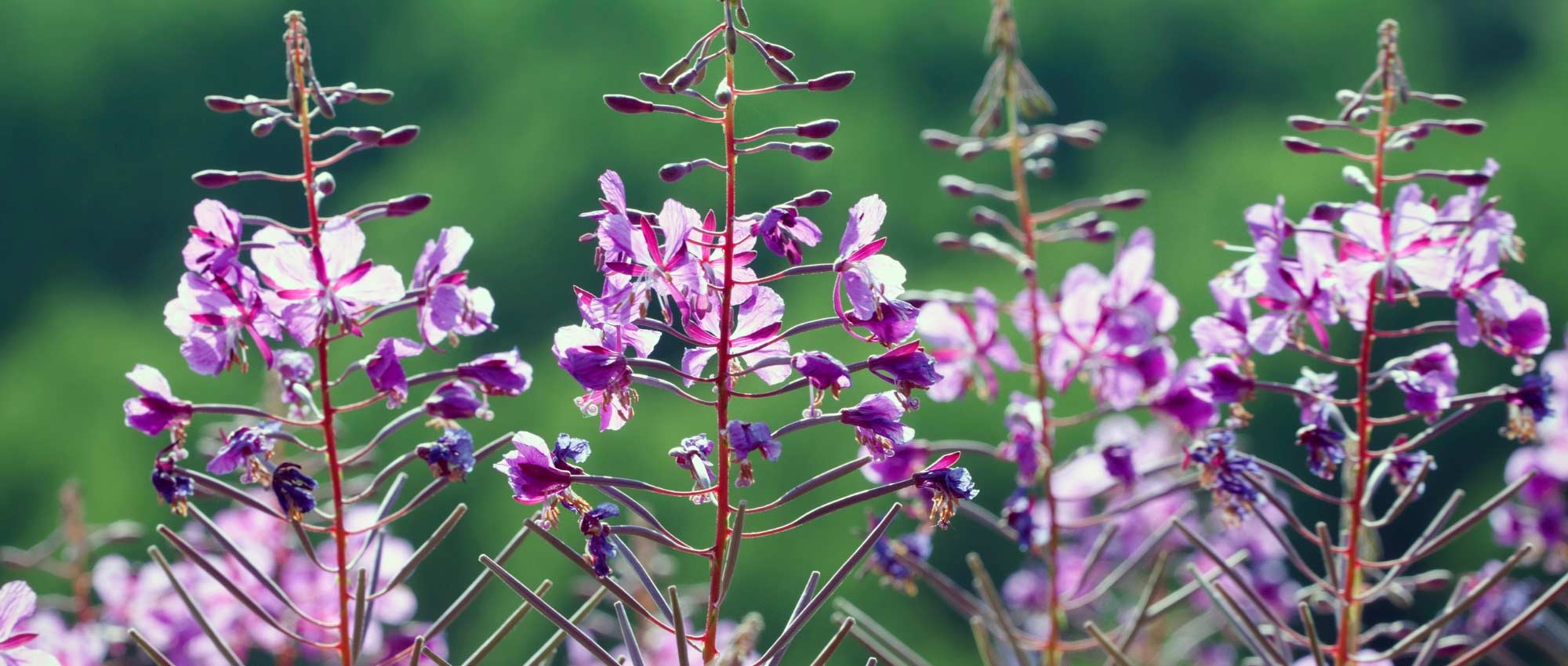
Willowherb: planting, cultivation and care
Contents
Epilobes in a nutshell
- Willowherbs produce large, upright inflorescences in summer, striking in appearance
- Their flowering is very bright, magenta-pink or white in colour
- They are generally fairly tall plants
- They are hardy and grow on their own, requiring little maintenance
- They can quickly form attractive colonies
- They thrive in full sun, in fairly moist soil, even at pond edges
A word from our expert
Willowherbs are plants that charm us with their large upright inflorescences, often composed of pink flowers. Cultivation focuses mainly on Epilobium angustifolium, or spike willowherb, a perennial that can reach 1.50 m in height. Flowers are pink for the type species, but there is also a superb white-flowered variety, Epilobium angustifolium‘Album’. Willowherbs are appreciated for their graceful, very airy flowering, whose colour brings a lot of brightness to borders.
Willowherbs thrive in full sun, on preferably fresh, even moist soil, and are ideal for planting on pond edges. They can easily manage without maintenance, although they appreciate some watering in periods of drought. They are plants that tend to spread to form handsome colonies.
Willowherbs have a rather natural look and fit easily into wild, country-style gardens. Epilobium angustifolium ‘Album’ finds its place easily in cottage gardens or in white borders, for an elegant, timeless look. It is also ideal for bringing brightness to rather shaded borders. You can use it to create contrast alongside plants with black or dark green foliage.
Botany
Botanical data
- Latin name Epilobium sp.
- Family Onagraceae
- Common name Willowherb, Saint Anthony's laurel
- Flowering June to October
- Height up to 1.5 m
- Sun exposure full sun, possibly partial shade
- Soil type fresh to moist, fertile
- Hardiness between -15 and -20 °C
The willowherbs comprise 220 species of plants, generally herbaceous, which can be perennial, annual or biennial. They are fairly hardy and well suited to our climates. The best-known and most widely cultivated species is Epilobium angustifolium, also called willowherb in spike. It originates from temperate regions of the Northern Hemisphere (notably Europe and North America).
In France, 18 species occur in the wild. In natural situations, Epilobium angustifolium grows in open, clear habitats. It is a pioneer species: among first to colonise newly freed spaces (forest clearings, fires, etc.), which explains its preference for sunny sites. It is often found in disturbed ground: embankments, waste ground, derelict lots, roadsides or railway verges, scree… as well as on damp ground and riverbanks. It grows on plains and in mountains, up to 2,500 m altitude. Where it establishes, willowherb generally forms large populations; finding a single individual is rare. Willowherbs arrive at a new site and quickly become abundant, spreading fast. They prosper while light is plentiful and competition low. Later, if the habitat closes up and forest returns, they gradually disappear.
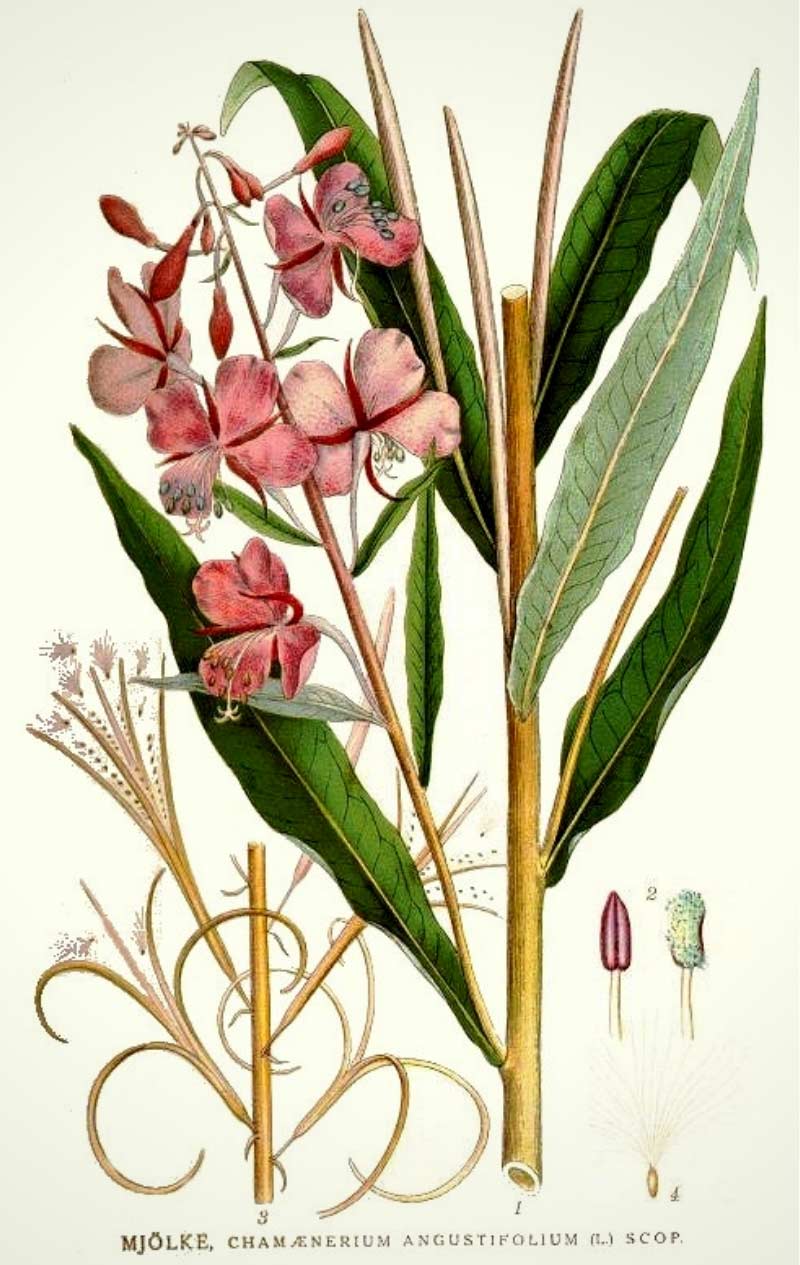
Epilobium angustifolium: botanical illustration
Willowherbs belong to family Onagraceae (about 830 species), alongside fuchsias, guaras, evening primroses, water primroses and ludwigia… They are herbaceous or shrubby plants bearing hermaphrodite flowers with often four petals. Willowherbs are very close to genus Chamaenerion, to the point that Epilobium angustifolium can also be found under name Chamaenerion angustifolium (synonym). Likewise, the California fuchsia (Zauschneria californica) is sometimes considered a willowherb and then named Epilobium canum.
Willowherb bears common names Willowherb, Saint Anthony’s laurel and basket willow, probably because leaf shape resembles laurel and willow; in English, willowherbs are called willowherbs (willow = saule). They are also known as fireweeds, since they are among first to appear after fire. Scientific name comes from Greek epi: above, and lobion: small pod or siliqua, because floral parts (petals, sepals…) are inserted above ovary, which will form the fruit. Species epithet angustifolium means “narrow-leaved”.
Willowherbs grow quickly, but mature height varies widely by species. They range from 10 cm to 1.5 m tall. Low-growing species form small spreading clumps: for example Epilobium crassum is creeping and remains at ground level. At the other extreme, the largest are Epilobium angustifolium, imposing perennials that are particularly vigorous.
Some willowherb species produce stolons, stems that root on contact with soil, allowing spread.
Epilobium angustifolium bears long upright, unbranched stems with leaves arranged along them and clusters of flowers at the top. Stems are thick, robust and often slightly reddish.
Flowering of willowherbs occurs in summer. Flowering of Epilobium angustifolium is long, usually from June to September–October.
Willowherbs then carry long erect clusters of many flowers at stem tips. Hence common name willowherb in spike (even though, botanically, the inflorescence is closer to a cluster than a spike). Inflorescences are graceful and striking. Clusters contain many flowers but remain rather airy; they retain a light, open aspect. Flowers open progressively from bottom to top. It is therefore possible to see fruits at base of inflorescence, open flowers in middle and buds at top, corresponding to different stages of flower ripeness. However, some species have solitary flowers: Epilobium crassum, Epilobium glabellum…
Flowers of Epilobium angustifolium are pink–magenta, but varieties with white flowers also exist (there is even a pale yellow-flowered species: Epilobium luteum!). White-flowered forms bring lightness and elegance, creating attractive contrast with darker plants. Flowering of Epilobium angustifolium ‘Album’ is especially graceful and pairs well with other white-flowering plants. Pink-flowered species add dynamism and vitality, with vivid hues that catch the eye.
Epilobium glabellum stands out for superb white, cup-shaped flowers with deeply notched petals. Willowherb flowers can also be funnel-shaped, with a long flared tube.

An inflorescence of Epilobium angustifolium / Pollination of a willowherb (photo Rüdiger Stehn) / Detail of a flower of Epilobium angustifolium ‘Stahl Rose’ (photo V. Elayne)
Flowers consist of four petals, unequal in shape but with rounded margins. They are open and spreading. Flowers also have four sepals, placed among petals and often matching petal colour, harmonising nicely. In Epilobium angustifolium sepals are slightly darker pink than petals. From centre of flower emerge eight stamens and a style, directed downwards. Tip of style (female organ) forms four stigmas arranged in a cross.
Flowers are hermaphrodite: bearing both male and female organs, though maturity of these organs is slightly staggered. Stamens release pollen before female parts (pistil) are receptive. This prevents self-fertilization and promotes cross-pollination via insects. Willowherbs are also good melliferous plants; pollinated by bees and producing excellent-quality honey.
Flowers are fairly large and well developed in Epilobium angustifolium, measuring 1–3 cm diameter; many species have much smaller flowers: Epilobium parviflorum, for example, bears tiny flowers.
Leaves of willowherbs are simple, entire and undivided. Leaves of Epilobium angustifolium are long and narrow, lanceolate in shape; Latin name literally “narrow-leaved”. They can reach 20 cm in length. Midrib is prominent. Secondary veins do not reach leaf margin but curve to meet each other, forming a marginal venation parallel to edge of lamina. Epilobium dodonaei has very different leaves, being very small and fine, linear; known as “rosemary-leaved willowherb”.

Foliage of variety ‘Stahl Rose’ and of Epilobium angustifolium ‘Album’ / Leaves of Epilobium fleischeri, much finer (photo Hectonichus)
Willowherb leaves are numerous and evenly distributed along stems. They are alternate and sessile, lamina attached directly to stem without petiole.
Leaves are green, sometimes slightly bluish. However Epilobium crassum has leaves more or less reddish, notably on underside.
Fruit is a long, slender capsule, reddish, containing very many seeds (several hundred per capsule). When ripe it opens by four valves from the tip. Seeds bear plume-like egrets and are carried by wind. Willowherb tends to self-sow. A young plant can easily produce thousands of seeds!
Willowherb colonises new territory thanks to numerous wind-dispersed seeds. Once established it spreads via underground rootstock, running. It can quickly form large colonies.

Fruits and seeds of willowherbs are very decorative! In order: Epilobium angustifolium (photo Dcrjsr), Epilobium hirsutum (photo Colin) and Epilobium tetragonum (photo Rasbak)
Read also
Care of perennial plantsMain varieties of willowherbs
Most popular varieties
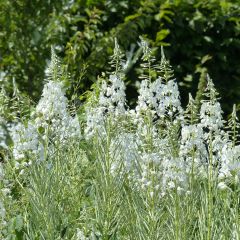
Epilobium angustifolium Album
- Flowering time July to October
- Height at maturity 1,50 m
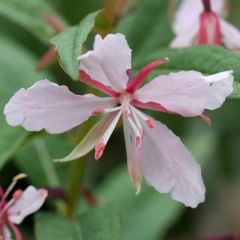
Epilobium angustifolium Stahl Rose
- Flowering time August to November
- Height at maturity 1,50 m
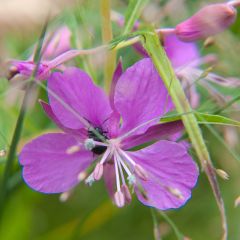
Epilobium fleischeri
- Flowering time August to October
- Height at maturity 25 cm
Discover other Epilobium - Willowherb
View all →Available in 1 sizes
Available in 1 sizes
Available in 2 sizes
Available in 1 sizes
Planting
Where to plant?
Plant willowherbs preferably in full sun, although they also tolerate partial shade. White-flowered varieties look particularly attractive in partial shade, where their flowers stand out more.
Willowherbs prefer cool, even moist soils, and do well on the margins of streams or ponds. They can create a superb natural scene, for example on the banks of a pond. Willowherbs appreciate fertile soils rich in humus, but will also grow on poor soils. As for pH, Epilobium angustifolium prefers slightly acidic substrates. Overall, willowherbs are not demanding plants: while they appreciate good garden soil, they can adapt and thrive on a variety of soil types.
As Epilobium angustifolium are fairly tall, we recommend placing them towards the back of borders, with smaller plants in front. They will enliven borders with their pink or white flowers while adding volume. If you grow smaller species such as Epilobium glabellum or Epilobium crassum, you can plant them in a rockery.
Because willowherbs grow unaided and require little maintenance, and because they fill space well, they are perfect for greening parts of the garden you rarely tend — difficult-to-maintain areas you can leave natural.
When to plant?
You can plant willowherb in spring (April–May) or in autumn (September–October). Most important is to avoid periods of frost or extreme heat.
How to plant?
For Epilobium angustifolium, allow a planting distance of about 50 cm.
- Start by placing your plant in a tub filled with water to re-moisten the root ball.
- Dig a planting hole two to three times the size of the root ball, and loosen the base.
- Take the plant out of its pot and set it in the planting hole.
- Replace the soil around it, then firm down to ensure good contact between soil and roots, avoiding air pockets.
- Water thoroughly.
Continue to water in the weeks that follow while the plant develops its root system.
Discover our video tips on planting perennials:
Care
Willowherb is a plant that grows easily on its own, without much attention. Its care requirements are fairly minimal. However, it prefers soils that remain moist: therefore it is best to water regularly if soil tends to dry out. This plant also likes fertile substrates but grows well in poor soil; it is not necessary to add fertiliser or compost.
We recommend cutting flowers when they are spent, as this encourages the plant to produce new ones, thus prolonging flowering. It also prevents the plant from self-seeding.
As for diseases, willowherb can be affected by rust. This fungal disease is recognised by orange pustules on the foliage. It weakens the plant but is generally not very serious. It is favoured by high humidity and poor air circulation. We recommend removing affected leaves and spraying a sulphur-based solution or a horsetail decoction. Willowherbs are also sometimes affected by downy mildew, which is also favoured by moisture. Finally, slugs and snails like to nibble the foliage of willowherbs. To protect your young plants, you can make a slug trap or use slug pellets such as Ferramol.
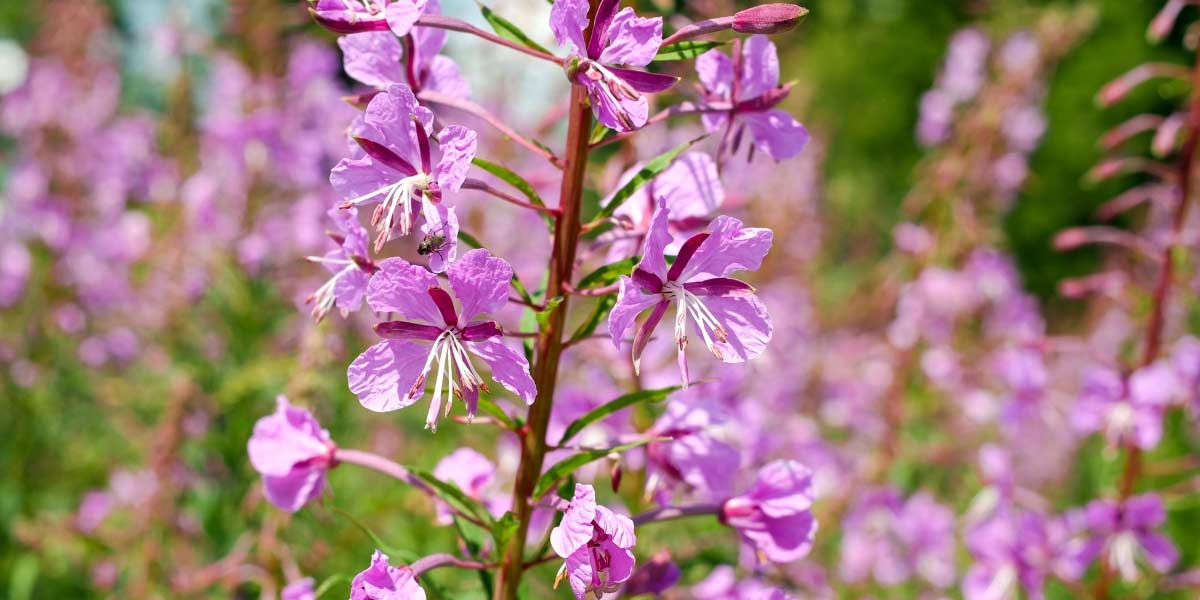
Propagation
Generally, willowherbs self-seed in the garden, but you can also try sowing. They can also be multiplied by propagation by cuttings or by division.
Sowing
You can sow willowherb seeds in late winter or early spring, around March.
- Prepare a pot or seed tray and fill it with sowing compost.
- Scatter the seeds on the surface.
- Cover them with a thin layer of sieved compost.
- Water gently with a fine spray.
- Place the pot under a cold frame in a bright spot.
Ensure the compost remains slightly moist until germination, watering occasionally if necessary.
You can also carry out direct sowing outdoors in autumn as soon as the seeds are ripe.
Willowherb seeds have better germination when fresh, recently harvested. They lose some of their viability over time, especially after more than a year. It is therefore best not to store them for too long.
Companion planting willowherbs in the garden
Being fairly tall, Epilobium angustifolium is best placed at the back of borders, where it will form a beautiful backdrop. It can be paired with Phlox paniculata, which produce flowers in similar shades. You can also plant a few hardy geraniums at the front of the border, which will charm you with their long flowering, often blue, mauve, pink or white.
With its elegant white flowering, Epilobium angustifolium ‘Album’ can easily fit into a cottage garden. Plant it with delphiniums, lupins, Centaurea cyanus, poppies, alliums, hardy geraniums… Also enjoy the delicate flowering of bellflowers! We recommend favouring pure white and deep blue tones: they work very well together and create a calming, delicate atmosphere.
As willowherb forms tall, supple clumps topped by airy flowering, you can use it to compose a naturalistic garden. Plant it alongside the delicate blooms of knautias, sanguisorbas, centaureas, bellflowers… Epilobium makes it easy to green up wild areas of the garden where little intervention is needed.
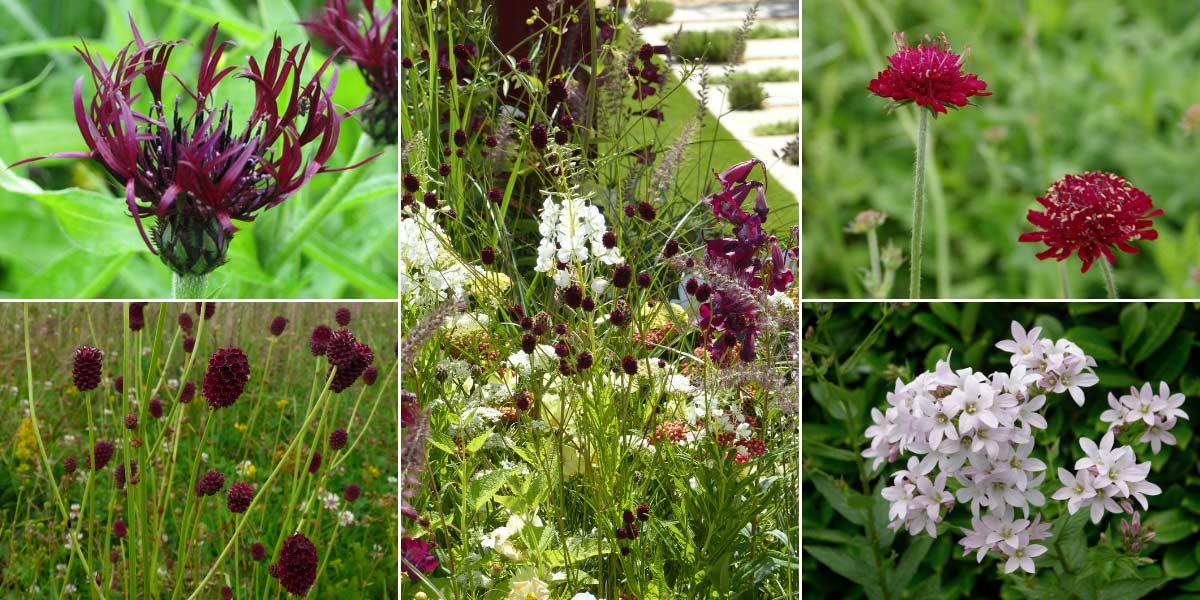
Willowherbs are perfect for creating a naturalistic garden! Centaurea montana ‘Jordy’ / Sanguisorba officinalis (photo Florian Grossir) / a planting with Epilobium angustifolium ‘Album’, Sanguisorba ‘Red Tip’, Penstemon and Pennisetum / Knautia macedonica / Campanula lactiflora ‘Loddon Anna’
Because they prefer fairly moist soils, willowherbs do well on pond margins. You can plant them with ferns, purple loosestrife, meadowsweet… Epilobium creates a fresh, calming atmosphere, ideal for recharging! Add other bold vegetation with well‑developed foliage: ferns, gunneras, reeds…
You can use Epilobium angustifolium ‘Album’ to compose a white garden. Pair it with gypsophilas, Achillea ptarmica, Clematis ‘Baby Star’, Digitalis purpurea ‘Alba’… You will achieve a graphic, timeless garden. Use this opportunity to play with shapes, for example by creating a contrast between rectilinear elements and airy, free‑growing plants. Enjoy the white, graphic flowering of agapanthus ‘Polar Ice’. You can also include plants with grey or variegated foliage.
Lastly, some species, such as Epilobium fleischeri or Epilobium dodonaei, can be planted in rock gardens. Choose companion plants with a matting or cushion habit. Opt, for example, for houseleeks, sedums, Delosperma cooperi…
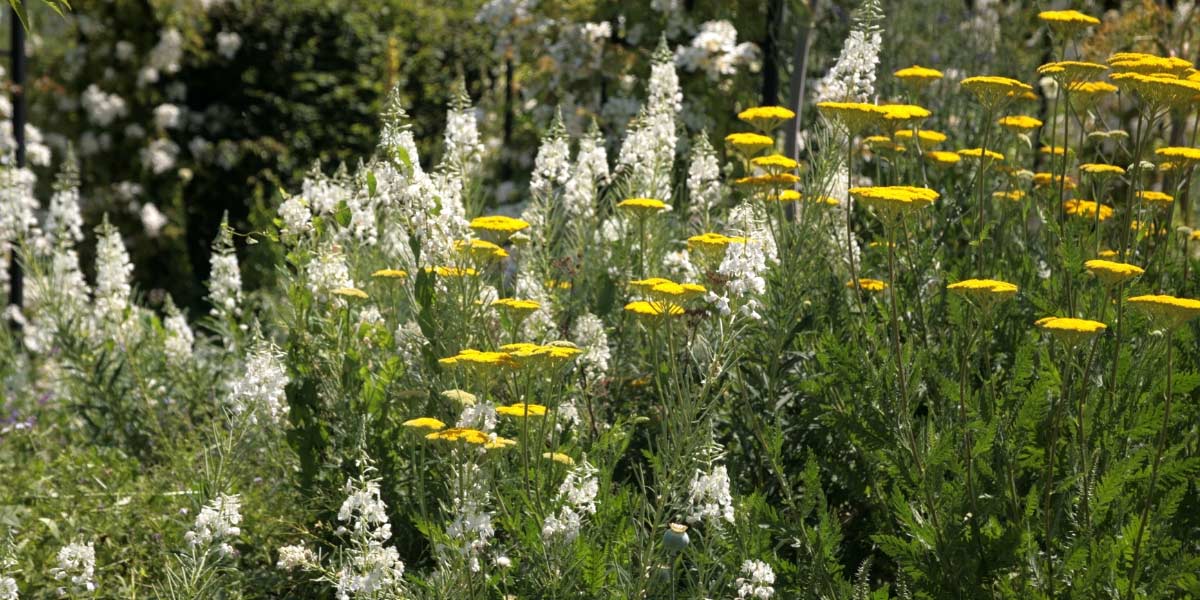
An idea for a pairing for a graphic, elegant border: Epilobium angustifolium ‘Album’ and Achillea filipendulina
Did you know?
- Medicinal properties
Epilobium angustifolium and Epilobium parviflorum are interesting for their medicinal properties: they are anti-inflammatory, support the immune system, are rich in antioxidants and effective against diarrhoea, cystitis, prostate disorders… They can be taken as herbal tea or in capsules.
Epilobium angustifolium also has the advantage of being edible. Young shoots and leaves, as well as flowers, can be eaten.
Useful resources
- Discover our range of willowherbs
- Inspiration for pairing willowherbs: naturalistic garden
- To pair willowherbs at the edge of a pond, discover our selection of shoreline perennials
- An article by Ingrid on our blog – Flower bed: vary and mix shapes!
Frequently asked questions
-
My willowherb's foliage looks chewed!
Slugs or snails have been around. They like to eat young leaves and shoots while still tender. You can protect your young plants by spreading sawdust around them to create a barrier, or by using slug pellets such as Ferramol.
-
Leaves on my willowherbs have orange spots.
Your plants are affected by rust, a fungal disease. Remove affected leaves and spray with a fungicidal product such as sulphur or a horsetail decoction.
-
How can I prevent willowherb from spreading in my garden?
The best technique is to cut off faded flowers, so the plant can no longer produce seeds. Moreover, this technique has the advantage of prolonging flowering! You can also plant it in a confined spot where its roots will be contained, or, for example, install a rootstock barrier when planting.
- Subscribe!
- Contents
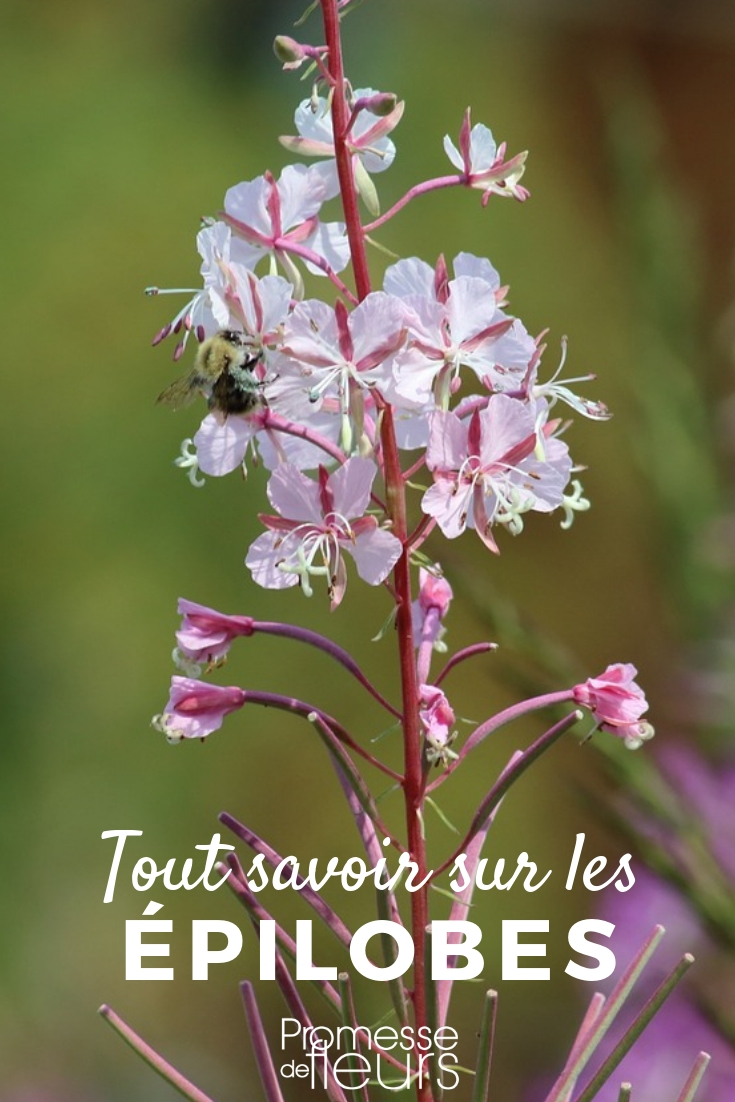


































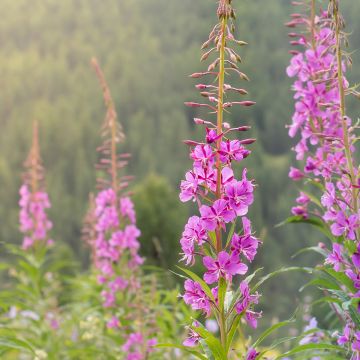
Comments